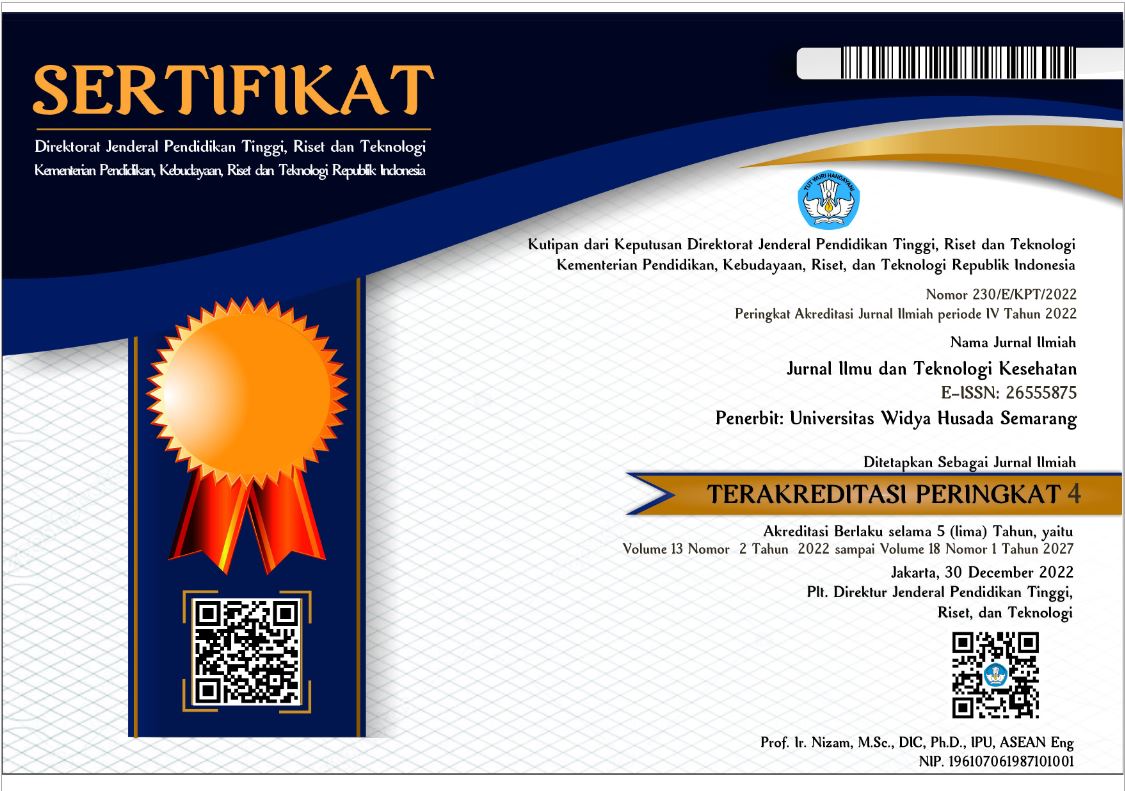ANALYSIS OF CRANIUM RADIOGRAPHY RESULTS WITH COMPARISON OF GRID RATIO 8:1 AND RATIOGRID 6:1 TO GET GOOD DENSITY VALUES
Abstract
This type of research is quantitative with experimental studies. It was carried out at the Radiology Installation of the Siti Rahmah Islamic Hospital, Padang. In May 2022. This research uses the ratio grid, Phantom Cranium and stepwadge. The results of the radiograph are then measured for the density value using a densitometer and displayed in the form of a table and the graph obtained is displayed in the form of tables and graphs.
The results showed that the radiographic density value of the Cranium Ap grid ratio of 8:1 was 0.69 and the 6:1 grid ratio was 0.75. The radiographic density value of the Cranium Lateral grid ratio of 8:1 is 0.67 and the 6:1 grid ratio is 0.88. From the density value, it can be concluded that the result of using the grid ratio on Cranium examination is good, namely the grid ratio of 8:1.
Keywords
Full Text:
PDFReferences
Akhadi, M. (2020) Dasar-dasar Proteksi Radiasi. Jakarta: Rineka Cipta.
Balingger, philip w (2019) Merril’s Atlas Of Radiographic Positions dan Radiologi Procedures.
Bontranger, kenneth l (2016) Textbook Of Radiographic Positioning and Related Anatomy.
Carroll, Q.B. (2019) Digital Radiography in Practice.
Dewilza, N., Yudha, S. and Alfareza, W. (2022) ‘Conventional Room Effectiveness Test Using Raysafe in Radiology Unit Siti Rahmah Islamic Hospital Padang’, Jurnal Ilmu dan
Teknologi Kesehatan, 13(1), pp. 11–17. Available at: https://doi.org/10.33666/jitk.v13i1.423.
Faiz M. Khan, J.P.G. (2014) The Physics of Radiation Therapy, 5a Edition, ISBN 978-1-4511-8245-3, pp.70.
Fauber (2000) Radiographic imaging & Exposure. st louis: mosby.
Notoadmojo (2010) metodologi penelitian. rineka cipta.
Perbankara (2007) ‘Pembuatan stepwedge berbahan aluminiumingot (Al ingot) primer sebagai guality control tool bidang radiografi’.
Priyono, S., Anam, C. and Wahyu Setia Budi, D. (2020) ‘Pengaruh Rasio Grid Terhadap Kualitas Radiograf Fantom Kepala’, Berkala Fisika, 23(1), pp. 10–16.
Rahman, N. (2009) Radiofotografi. padang: universitas baiturrahmah.
Rasad, S. (2005) RAdiologi Diagnostik. Jakarta: FK Universitas Indonesia.
Sparzinanda, E. (2017) ‘Pengaruh Faktor Eksposi Terhadap Kualitas Citra Radiografi’, Journal Online of Physics 3, 1, pp. 14–22.
Sugiarti, S., Jatmiko, A.W. and Plate, I. (2021) ‘Uji Kelayakan Apron Dengan Menggunakan Imaging Plate ( Ip ) Di’, Health Care Media, 5(1), pp. 8–15.
Sugiyono (2019) Metodologi Penelitian Kuantitatif & Kualitatif dan R&D. Bandung: Alfabeta.
Utami, A.P. (2016) Radiologi Dasar 1. magelang, jawa tengah: Inti media Pustaka.
Yudha, S. ;Nerifa D. diki isnardi (2023) ‘Making A Simple Tam-Em Board To Assist Radiological Examination In Babies Using Acrylic’, 14(1), pp. 1–16.
DOI: https://doi.org/10.33666/jitk.v14i2.570
Refbacks
- There are currently no refbacks.

This work is licensed under a Creative Commons Attribution 4.0 International License.
| Published by : Widya Husada Semarang University | ISSN : 2086-8510 (Print) | ISSN : 2655-5875 (Online) | |
| INDEXED BY | |||
 |  |  |  |
| MAP LOCATION | |||






